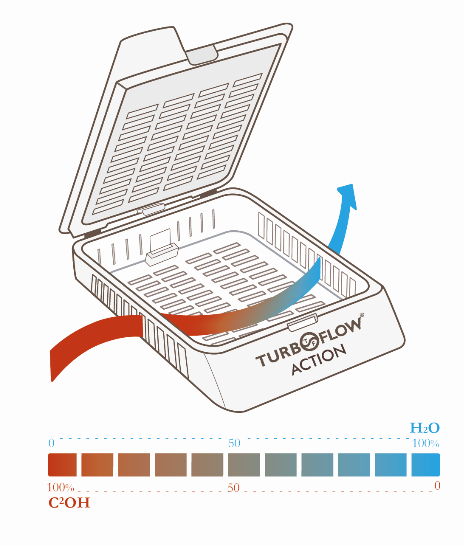In today’s Histopathology laboratory, particularly large volume labs, tissue cassette selection and use has been standardized down to one or two models of cassette; chosen to accommodate the general tissue(s) they work with. With labs predominately working with breast tissues, they would more than likely have cassettes that enhance the fluidic flow of reagents through the cassette. These cassettes would promote fluid infiltration of tissue, which in the case of breast tissues are more dense, fibrous, and oftentimes fatty specimens.
Cassettes that have larger pore sizes are in most cases, the most appropriate tool for larger specimens that may require standard to longer processing times. Failure to make this adjustment for those tissues can result in under-processed tissue and ultimately reprocessing steps. Reprocessed specimens rarely capture the true integrity and image of optimal processing, and in extreme cases can compromise the diagnostic ability of the pathologist. The top image to the right illustrates the larger pore size mentioned.
Laboratories working with routinely sized specimens will most often choose a standard size cassette with a multiple vent design on the top and bottom of the cassette. Although the vents are much smaller than the larger pores on the image above, they are numerous enough to promote fluid exchange and successfully process most tissues. This type of ‘standard’ sized cassette is illustrated in the center image. Note the vertical rows of vents in the cassette design.
The last image to the lower right shows a specialized cassette design known as the ‘biopsy cassette.’ It is specifically designed for biopsy, particulate, and most other small/minute tissue specimen types. With these cassettes, containment is the primary goal in the design such that even small particulate specimens cannot filter through the mesh like pores. These cassettes are most appropriate for needle cores, dermatological punch biopsies, fragmented tissues, and such. The pore size of this type of design can be as small as 0.67 mm., or even an actual mesh-like material.

There are three primary considerations that determine selecting a cassette that is optimized for the specific tissue(s) used: Tissue Prep – Grossing, Fluidic Flow, and Security.
Grossing – If the tissue is not optimally grossed, this can severely impact one’s ability to thoroughly process larger, fatty, or fibrous specimens. Colon, large intestine, cervix, are all examples of tissues that are more challenging. Even with the right cassette, which in this case would be the top image with larger pore sizes; the tissue most be grossed at 3-5 mm. thickness and grossed to a point where there is space around the tissue in the cassette.
Fluidic Flow – Fluidic Flow is a uniquely specific design created by noted Pathologist and inventor, Dr. James B. McCormick. This cassette design, originally named the Turbo-flow cassette, demonstrated the same multi-vertical vented rows, but also lateral vents on both sides of the cassette. It showed an enhanced ability to promote reagent flow, fluid exchange, and infiltration of tissue. This proved to be particularly useful in reducing the incidence of reprocessing due to improper grossing in breast specimen. Tissues that were grossed too thick or filling the capacity of the cassette with no space, now had an opportunity for adequate infiltration. All three cassette models previously shown are designed to accommodate fluidic flow for the appropriate tissue type.

Security – The last primary consideration in cassette selection; it is what drives the need for different types. The question becomes, ‘Is the cassette you have selected designed to contain the specimen and avoid any type of tissue loss due to tissue/fragment filtration through the pores. As you can see in all three designs, they all provide a proven ability to contain the tissue types for which they were designed. Because of the absolute mandate in histology that we must reduce/eliminate any ‘potential’ for tissue loss; added quality assurance is oftentimes employed by some form of internal containment device. This can be in the form of lens paper to wrap the specimen in the cassette, biopsy bags inside the cassette, or even a cassette-within a cassette (as seen in the image to the right); use whatever is necessary, even beyond the cassette design.

The information presented will help give thought to an item so commonly used in the Histology lab that we seldom give it the attention required to optimally handle and process tissues. Take time to review and possibly upgrade your cassette choices to ensure best practices and the highest probability of success.
References:
- Brown, S., ‘Basic Dynamics of Fluid Transfer in Fixation & Processing,’ Lab Management Consultants-Technical Series, 2018.
- McCormick, JB, Brown, S., Dickey, L., ‘Snippetology-From Hunks to Snippets,’ Workshop-Missouri Society of Histotechnology Symposium, 2007.
- www.labstore.com
